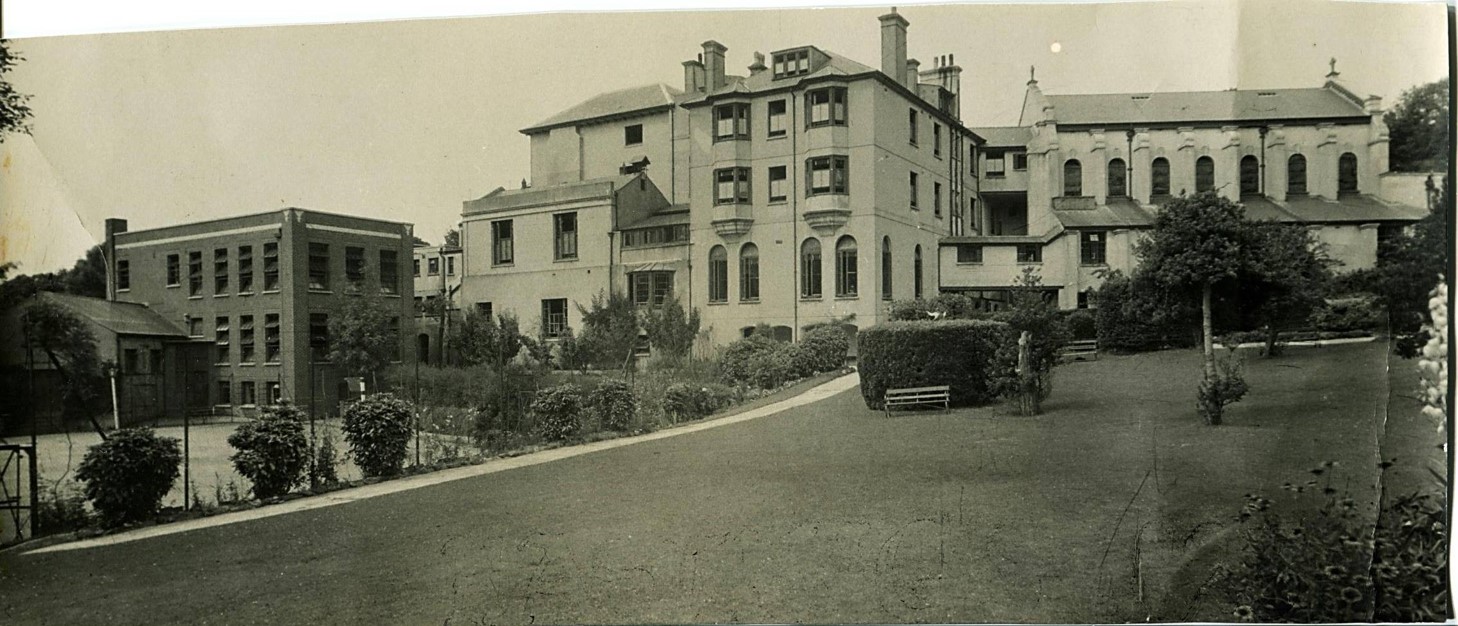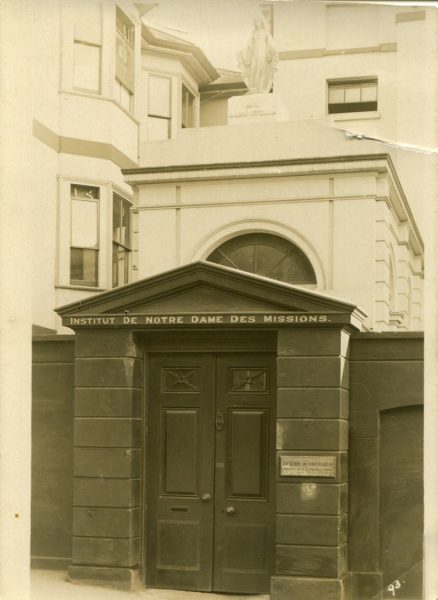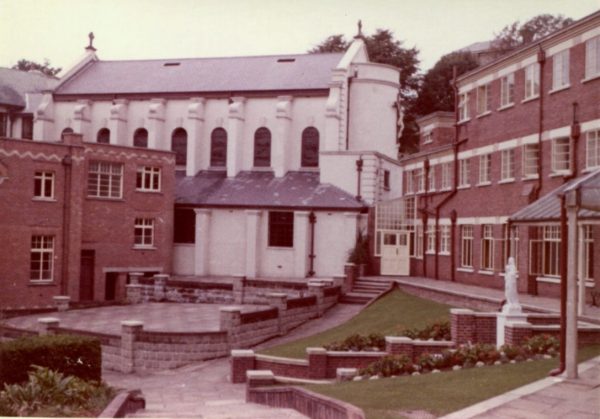
We would like to introduce the beginning of our commemoration by re- visiting our special heritage site within the UK and Ireland Province; the Juniorate, Novitiate, Generalate Provincialate and Community in the House on the Hill- Hastings. We will dedicate our next newsletter to the memories of our years in Hastings. Thank you to the sisters who have shared memories with us – we will be sharing your stories over these two months of commemoration.
Reviewing our History:
 In the year 1895, the rector Fr. Dominic Crescitelli invited the sisters to teach in the parish school. The records say that six sisters lived at “The Croft” at 3 High Street. As all beginnings, they had their own difficulties: extreme poverty and struggles of mission. Since they had few sisters to be on mission they withdrew in 1911. The parish school wanted the sisters back because the people were convinced that nothing could replace the influence of religious presence in a school.
In the year 1895, the rector Fr. Dominic Crescitelli invited the sisters to teach in the parish school. The records say that six sisters lived at “The Croft” at 3 High Street. As all beginnings, they had their own difficulties: extreme poverty and struggles of mission. Since they had few sisters to be on mission they withdrew in 1911. The parish school wanted the sisters back because the people were convinced that nothing could replace the influence of religious presence in a school.
Sisters Marie. St. Sindonis, and Marie. St. Etienne were the first community members to restart the mission in July 1922, along with a group of Novices. Marie St. Hippolyte and few more novices arrived on February 7 and the novitiate was canonically established in Hastings. Later Mary St. Pacȏme, then Superior General, came along with Marie St Rosaire and this convent became the Mother House, the Eighth General chapter took place in Hastings in the year 1925.
Hastings stood on the coast of the English Channel and in 1939, it also faced the beginning of the Second World War. In the year 1968 a decision was made to transfer the Generalate to Rome and Hastings became the first Provincialate for the British Isles and Ireland Province.
Hastings created a well-structured environment for formation, the sisters’ contribution to the school and our Parish ministry played an important role in the congregation’s history.
Adapted from the account written by Maria McMahon and Pauline McDonald in RNDM Zeal for Mission complied by Susan Smith.
Reflection from the sisters
 Hastings played a pivotal role in the life of the Congregation and of our Province. For many years it was the “Mother House”, home to the Leadership and Administration of the Congregation worldwide as well as being the place of formation for new members. As a young teenager, just at the start of my journey into religious life, I was over-awed by its size and the many sisters living there. There was a sense of great activity but also of silence throughout the house.
Hastings played a pivotal role in the life of the Congregation and of our Province. For many years it was the “Mother House”, home to the Leadership and Administration of the Congregation worldwide as well as being the place of formation for new members. As a young teenager, just at the start of my journey into religious life, I was over-awed by its size and the many sisters living there. There was a sense of great activity but also of silence throughout the house.
As I continued in formation I appreciated the rhythm of life and the richness of the liturgy in our beautiful chapel. Having said that, I recall many of us as novices vented our emotions and energy in wielding heavy “shiners” to polish the floor!!
Being the Mother House there was always many comings and goings. Sisters being missioned abroad or to other parts of the Province, students returning from colleges etc. But when it was time for a General Chapter there was an even greater buzz of excitement as we prepared to welcome our sisters from around the world. One felt part of something vibrant and bigger than just our own place. It was fascinating to hear of the work being undertaken in so many different countries and the dedication of the sisters. I am sure it nourished and encouraged many of us to persevere in our life of commitment as RNDMs.
My first mission, after perpetual profession, was to Hastings as a teacher in Sacred Heart Primary School where I had finished my own schooling years before. During my time there I was able to get closer to the people of Hastings and to get to know more of its history and its geography. I came to love the pathways, roads of the Old Town as I visited families of the children in school on a weekly basis. Being by the sea was an added bonus!
Looking at the convent, as we climbed up the hill, we could never have imagined that in a relatively short period of time it would close. The Generalate moved to Rome and the British Isles became a province with its own leadership for the first time. This was a period of re-adjustment for us because for years we had been governed directly by the Generalate leadership. Later the property was sold and the sisters dispersed around the province. I was away in Kenya during this painful time of closure for the community in Hastings. Change is never easy. Naively I expected our Hastings home to be there forever!
Pauline McDonald, RNDM
The Juniorate in Hastings was set up in 1922 and catered for young girls who felt called to be a Sister of Our Lady of the Missions. The young girls continued their schooling at Sacred Heart College which was attached to the convent and so they began their preparation for a future career in teaching which had been the principal missionary work of the Sisters in the early days. They had two professed Sisters in charge of them and one of them had her sleeping accommodation in a separate building from the convent with the Juvenists. Meals and study took place in a part of the convent reserved for the Juvenists, the meals being brought from the convent kitchen. There was a fairly strict routine with attendance at daily Mass and other spiritual devotions and time set apart for study. This was supervised by one of the Sisters. Weekends were slightly more relaxed and there were often walks organised up to the hills surrounding Hastings. The highlight for some was the Sunday evening “teaching” of Scottish dancing by one of the Sisters. It was a time of fun as well as learning. Letter writing to family was encouraged – no mobiles at that time! Young girls came from different parts of Ireland, Scotland and England and occasionally France so it was a good introduction to intercultural living! Visits would have been allowed but for many of the families, coming down to England from Scotland or across from Ireland or France would have been expensive and travel was not so easy. Home visits were allowed in the summer only and there was the long break and mostly good weather!
As Hastings was also the Novitiate house and where some Sisters in Temporary Profession lived, there were strict rules regarding contact with either group of Sisters. Although taught by some of the Sisters in school, contact with them outside school hours was not really permitted.
Looking back on it, the Juniorate was a highly organised, structured time for young girls, especially those who had been used to their freedom. It was probably reminiscent of the times we lived in, trying to protect and nurture these young vocations.
Margo Murphy, RNDM
It was in 1949 that I left home to go to Hastings which was the Mother house then. I spent years of formation: Postulancy, Novitiate and Juniorate in Hastings. It was an exemplary life of the sisters in serving God and his people. It was admirable, they had religious modesty, discipline, importance to prayer life and very gracious. I recall Hastings as the happiest place; I loved working there, a lovely community spirit that was alive and active, sisters were friendly and hospitable to family members when they visited their daughters; they were six postulants when I entered.
The sisters worked as a team with a missionary spirit. M. M. St. Gabriel Lagan was there as prioress. It was challenging but I accepted it because I chose this way of life to serve God’s people. I made first profession in 1952, and asked to help in the infirmary – to look after the sick, take shifts in the kitchen and house hold cleaning. I was missioned to Wealdstone then returned for perpetual profession preparation and stayed back in Hastings when M. M. St. Denis asked me to take care of the sacristy of the chapel. I lived 8 years in Hastings. Little did I know it was the foundation of my becoming a nurse and a missionary in Kenya years later.
Bernardine Corcoran, RNDM